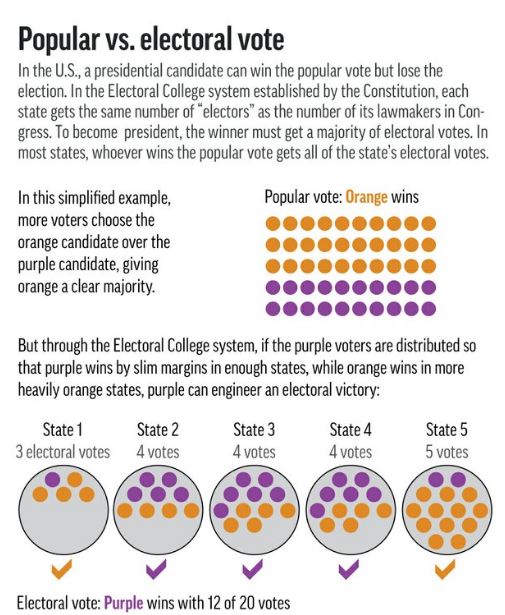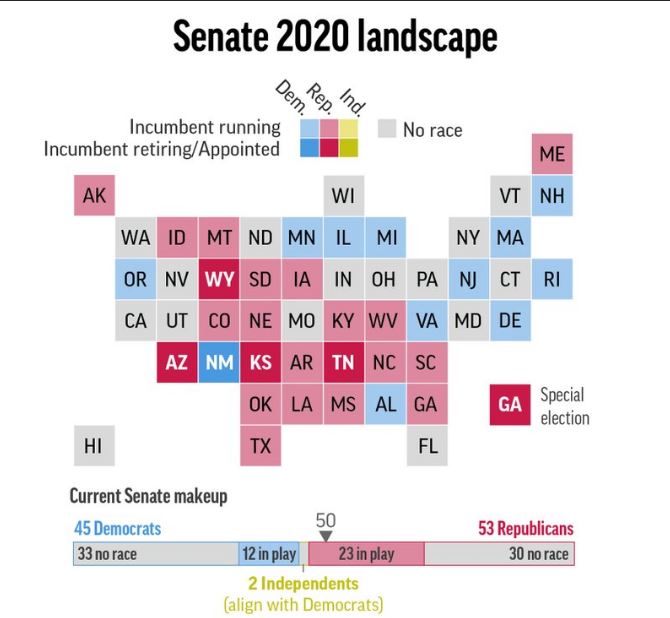From beginning to end: The complete US Election process

To be elected president, the winner must get at least 270 electoral college votes
(Web Desk) - In the United States, the winner of a presidential election is determined not by a national vote but through a system called the Electoral College, which allots “electoral votes” to all 50 states and the District of Columbia based on their population.
As Donald Trump and Joe Biden go into next week’s election to become the next US President, it is important to understand what the Electoral College is and why it is preferred over popular voting by the US.
Electoral College vs popular vote in the United States
Why is it that one candidate can win the popular vote but another wins the electoral vote and thus the presidency?
Because that’s how the framers of the US Constitution set it up.
This unique system of electing presidents is a big reason why Donald Trump won the presidency in 2016. Four candidates in history have won the popular vote only to be denied the presidency by the Electoral College.
The Electoral College was devised at the Constitutional Convention in 1787. It was a compromise between those who wanted direct popular elections for president and those who preferred to have Congress decide. At a time of little national identity and competition among the states, there were concerns that people would favor their regional candidates and that big states with denser populations would dominate the vote.
Disproportionate importance of states
The Electoral College has 538 members, with the number allocated to each state based on how many representatives it has in the House plus its two senators.
To be elected president, the winner must get at least half plus one — or 270 electoral votes.
This hybrid system means that more weight is given to a single vote in a small state than the vote of someone in a large state, leading to outcomes at times that have been at odds with the popular vote.
Below are the key dates in the election process starting from election day, and what happens each step of the way.
Nov. 3: The first step is Election Day. Voters in all 50 states technically are not voting for a president, but for a slate of electors who are pledged to support one of the presidential candidates in a later vote. Voters can cast their ballots on or before Nov. 3, but voting stops when polls close. States then can count the votes.
Late November/Early December: Each state has its own deadline to certify the election. However, if ballot disputes, litigation or other factors delay the count, blowing this deadline doesn’t invoke a penalty in the presidential race. The big deadlines are still to come.
Dec. 8: This is known as the safe harbor deadline. That means that Congress cannnot challenge any electors named by this date in accordance with state law. Most states want their electors named by this deadline, to ensure Congress cannot disregard them.
Dec. 14: This is the date when electors are required to meet in their states and cast their ballots for president. Missing this deadline could mean a state’s electors don’t count in the presidential tally. Any electors seated between Dec. 8 and this date can still vote, but they could theoretically be challenged by Congress. Also, by this date the governor of each state must certify the state’s presidential election and slate of electors.
Dec. 23: The states are supposed to transmit their votes to Congress by this date.
Jan. 3: The new Congress is sworn in.
Jan. 6: Congress counts the electoral votes. Typically, this process formally certifies a winner.
Inauguration Day
Inauguration Day takes place on January 20 at the U.S. Capitol building in Washington D.C. First, the Vice President is sworn in, followed by the President. Both officially become President and Vice President after reciting the oath of office which has been used since the late 18th century.
Effect of General Elections on Congress
The makeup of Congress will be determined by the general election, with both parties needing a majority to control the House or Senate.
Democrats seem to have a good chance at winning a Senate majority, while their control of the House is not in serious doubt.
Republicans hold the Senate 53-47. Democrats must gain at least three seats to win control, or four if President Donald Trump is reelected and Vice President Mike Pence can break a tie.
Only one-third of the 100 Senate seats up are for reelection since senators serve six-year terms. This year, 35 Senate seats are up for grabs, and around a dozen GOP-held seats and two Democratic-held seats seem competitive.
In the 435-member House, Democrats are the ones defending the majority. Republicans currently hold 197 House seats and need 218 to win control. There are also four open seats that had been held by Republicans until they resigned and left office earlier this year.
And if the Election results become contentious?
Even if the election is messy and contested in court, the country will have a president on Inauguration Day. The Constitution and federal law ensure it. Here’s what happens after voters go to the polls on Nov. 3:
Courts will be mindful of that in refereeing any disputes. During the 2000 election, the U.S. Supreme Court ultimately ended Florida’s vote recount, saying time had run out before electors were set to meet.
So what happens if election issues still prevent a winner from being named? The Constitution has an answer.
The 12th Amendment says that in that case, the House of Representatives elects the president and the Senate elects the vice president. The new Congress that enters in January is the one tasked with carrying out the so-called “contingent election.” The president has only been selected this way once, in 1825. The winner was John Quincy Adams.
In a contingent election, House members have to choose among the three people with the most electoral votes. Each state delegation gets one vote, and 26 votes are required to win. In the Senate, the choice is between the top two electoral vote-getters and each senator gets a vote, with 51 votes required to win.
What if that fails and the House hasn’t elected a president by Inauguration Day? Then the 20th Amendment takes over. It says the vice president-elect acts as president until a president is picked. And if there’s no vice president selected by Inauguration Day?
Well, then the Presidential Succession Act applies. It says that the speaker of the House of Representatives, the Senate president or a Cabinet officer, in that order, would act as president until there’s a president or vice president.





